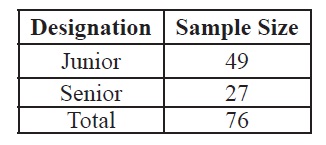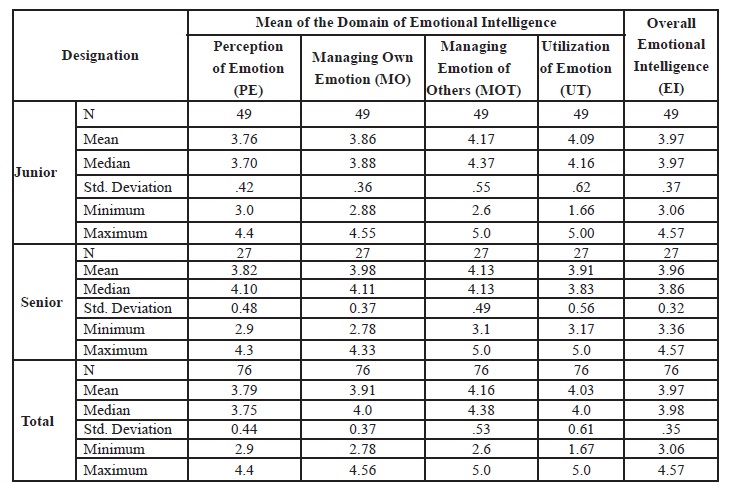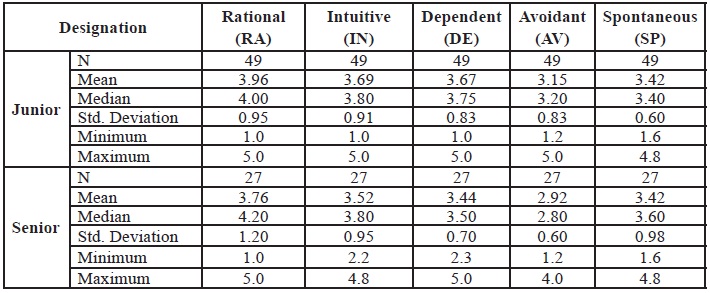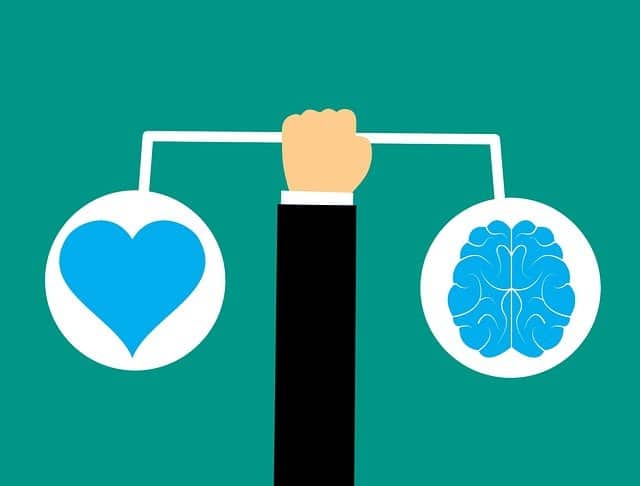THE ROLE OF EMOTIONAL INTELLIGENCE IN THE DECISION-MAKING PROCESS OF CORRECTIONAL OFFICERS, OF THE WEST BENGAL CORRECTIONAL SERVICES
One of the most significant roles of a leader or manager of any workplace is decision making, where their decisions are based on knowledge, rationality, memory as well as emotional components. Formerly, correctional homes were known as jails or prisons for punishment. With the changing scenario in the context of human values, it is presently known as a correctional home, where the main objective is care, correction, and counselling. The uniqueness of this service demands learning for critical decision-making under stressful situations. At the same time,, the level of emotional intelligence of the correctional officers help them to precisely understand their own emotions as well as the emotions of the inmates so that as leaders of the correctional home they can make decisions effectively. This study makes an attempt to analyze the effect of emotional intelligence on the decision-making process. Data was collected from 76 correctional officers of the West Bengal Correctional Services, by means of structured close-ended questionnaires, in a series of face-to-face interaction; focusing on their self-perceived emotional intelligence and decision making. Results show that the level of emotional intelligence and decision-making skills of the correctional officers are satisfactorily high. Correlation studies between emotional intelligence and the decision-making process show, that the perception of their own emotions, is a good predictor of the supervisor’s transformational leadership. Regression analysis indicates that domains of emotional intelligence have a facilitating effect on two types of decision-making styles viz, intuitive and spontaneous. Other styles are usually free from the influence of emotional intelligence.
INTRODUCTION
One of the most significant roles of the leader or manager of any workplace is decision making, where their decisions are based on knowledge, rationality, memory as well as emotional components. According to Dahling & Perez, (2010) a decision maker’s emotional processing ability depends on previous experience, their current emotional capacity, and the emotional investment an individual is willing to make in the decision’s outcome. In a nutshell, emotional intelligence plays a significant role in decision-making. As Correctional Officers play a special and different kind of role, the present study tries to find out the relationship between decision making and emotional intelligence of the Correctional Officers of West Bengal. Regression analysis indicates that the domains of emotional intelligence have a facilitating effect on two types of decision-making styles viz, intuitive and spontaneous. Other styles are free from the influence of emotional intelligence.
Duties of Correctional Officers
Formerly correctional homes were known as jails or prisons meant for punishment. With the changing scenario regarding human values, it is presently known as a correctional home, where the main objective is care, correction and counseling. The inmates by being imprisoned, are already punished; so there is no need to impose any further punishment by the Correctional officers. Naturally, the mindsets and behaviors of Correctional Officers are gradually changing. To fulfill the objective of ‘care’, they monitor and supervise adult offenders for the safety and well-being of the public, the staff, and the inmates themselves. They are expected to communicate and interact with inmates in the line of thought of counseling. Though the officers receive rigorous training at the Institute of Correctional Administration to interact with inmates in a variety of situations, due to the unique nature of the job, the possibility remains to encounter a totally unknown and unique situation.
Judgment & Decision-Making by Correctional Officers –
Decision-making towards persons, objects or situations is done on the basis of the selection of available alternative ways of responses or paths. Correctional Officers during their basic training learn a number of alternative ways of decision making, as well as about their authority for taking decisions as per positional orders, institutional orders, and directives policies. Apart from that, the uniqueness of this service demands learning for critical decisions under stressful situations. Specifically, in a crisis situation, there should be room made for actions or decisions, which require specific training to be effective.
Defining Emotional Intelligence (EI)
Goleman (1998) considered four basic components that determine the concept of emotional intelligence self-awareness, social awareness, self-management, and social skills. According to him, these components manipulate
the process of controlling one’s own emotions and the emotion of others, which play a bigger role than cognitive intelligence in determining success in life and in the workplace. According to Marian et al (2001), emotional intelligence focuses not only on emotions but an array of non-cognitive abilities that help people adapt to all aspects of life. In Morand’s (2001) view emotional intelligence is the individual’s awareness and ability to express their own emotions and their perception of others’ emotions.
Emotional Intelligence and Leadership
According to Gerstner & Day (1997), emotionally intelligent leaders develop an atmosphere of enthusiasm, excitement, optimism, cooperation, and trust with their followers. Conger & Kanungo, (1998) and Yukl, (1998), identified, that emotionally intelligent leaders could effectively develop goal-directed behavior, appreciative inquiry, and flexibility in decision making during periods of change.
Emotions in the Decision Making Process of Leaders
Decision-makers can utilize self-management skills to establish a consistent record of achievement and emotional control, while simultaneously earning trust from both internal and external constituents. The skill of social
awareness and its core competencies of empathy, service orientation, and organizational awareness of decision-makers, is used to judge the impact of not only their decisions but also the manner in which those decisions are made; and is an important constituent of emotional intelligence state Goleman (2001) and Boyatzis et al., (2000). According to Druker, P.F (2004), “Whatever a manager does he does through decision making.” Decision-making is so crucial to the job of managing, that it is called the heart of management. However, decision-making is only one of the ways in which managers can influence the effective accomplishment of goals. Thus decision-making is the primary task of management. Cherniss and Adler (2000) defined emotional intelligence as the ability to accurately identify
and understand one’s own emotional reactions and those of others. It also involves the ability to regulate one’s emotions, to use them to make good decision making, and act effectively. George (2000) suggested that feelings
(moods and emotions) play a central role in the leadership process. Further her study proposed, that emotional intelligence, the ability to understand and manage moods emotions in the self and others, contributes to effective
leadership in an organization.
Literature Review
Emotional Intelligence
Leban (2003) identified that the success of complex projects depends on the relationship between rational leadership behavior and the emotional intelligence of the project manager. A study on emotional intelligence,
leadership style, and coping mechanisms of executives by Purkable, (2003) opined, that the organizational leaders frequently use emotions to influence the affective states of others, which is a significant part of charisma. Studies on the US Air Force (2002) when they began using emotional intelligence tests to select recruits showed, it immediately saved $3 million a year through greater effectiveness, lower turnover, and associated costs. Boyatzis (2001) studying several hundred managers from 12 different organizations showed one of the foundations of emotional competence being accurate self-assessment, which was associated with superior performance. Ciarrochi et al (2000) argued, that the ability to cope with aversive and stressful situations is related to one’s ability to manage emotions. The Consortium for Research on Emotional Intelligence in Organization (2000) points out that in a manufacturing plant, after the supervisor received training in emotional competencies, production increased by 17%.
Goleman (1998) in his research indicated that the managers who do not feel a responsibility to others, can’t handle stress, are unaware of their own emotions, lack the ability to understand others, or erupt into anger easily are viewed as likely to derail due to problems dealing with other people. Studies by Kruger and Dunning (1999) and Shipper and Dillard (2000) reported, that non-cognitive functioning like overestimation of competency are shown by unsuccessful supervisors compared to successful supervisors.
Decision Making
Reeves (2012) in his study found, that decision-making was associated with both perceived supervisor support and perceived organizational support, those being the components of emotional intelligence. George (2000) identified that a better way of decision making by the leaders depends on how far they know and manage their emotions. George and Bettenhausen (1990) point out, “The extent to which leaders of existing workgroups experienced positive moods was positively related to levels of pro-social behavior performed by group members and negatively related to group turnover rates.” But none of the studies have been conducted in the study area. In order to fulfill this research gap, this study makes an attempt to analyze the effect of emotional intelligence on the decision-making process.
Objectives of the Study
1. To measure the level of emotional intelligence and its components.
2. To measure the level of decision-making and its components.
3. To identify the relationship between emotional intelligence and decision making, of the Correctional Officers of the West Bengal Correctional Service.
Methodology
Sample and Procedure
The present research investigated how the perception of emotions, managing own emotions, managing the emotions of others, and the utilization of emotions of others, are associated with the decision making of the Correctional
Officers.
Sample Profile: A sample profile is shown in Table 1
Table 1: Sample Profile with Frequency Distribution of Sample

Data Collection:
Data was collected by means of structured close-ended questionnaires, in a series of face-to-face interactions regarding their self-perceived emotional intelligence and decision making, group-wise within a gap of 15 days or more. Furthermore, in-depth interviews were conducted in order to collect qualitative information from their comments and observations.
Measurement
Emotional Intelligence (EI):
The selected components of supervisory EI (perception of emotion, managing own emotion, managing emotion of others, and utilization of emotion were measured with items adopted from the widely used Schutte Emotional Intelligence Scale (SEIS) (1998). The SEIS comprises of 33 self-referencing statements and requires subjects to rate the extent to which they agree or disagree with each statement on a five-point scale (1 =strongly disagree; 5 = strongly agree). Participants reply on a Likert scale and a total score is derived by summing up the item responses. The brevity of the scale and its accumulating reliability and validity evidence, makes this scale a reasonable choice for those that are seeking a brief self report measure of a global EI. Initially an instrument was designed and filled out by a group of supervisor (n =90). After completion a open conversation and qualitative discussion with the participants were taken place to get insight of the participants. Face validity of the instrument was done by two
management faculties and other two faculties of industrial psychology. Special attempts were made to make the items free from the contamination of social desirability. Final scale items were considered after conducting
factor analysis.
The General Decision-Making Style (GDMS)
The General Decision Making Style test is a psychological instrument developed by Scott and Bruce (1995) to assess, how individuals approach decision situations. In their conception, a decision making style is a learned habitual response, resulting in a habit-based propensity to react in a certain way in a specific decision context. It has been found that people use more than one decision making style, but one is generally found dominant. It distinguishes between 5 decision styles.
• A rational style emphasizes a thorough search for and logical evaluation
of alternatives.
• An avoidant style emphasizes postponing and avoiding decisions.
• A dependent style emphasizes a search for advice and direction from
others.
• An intuitive style emphasizes a reliance on hunches and feelings.
• A spontaneous style emphasizes a sense of immediacy, and a desire to get through the decision making process as soon as possible.
There are 25 items using a 5 point ratings (1 = strongly disagree to 5 = strongly agree) in 5 sub-scales: Rational, Avoidant, Dependent, Intuitive and Spontaneous. To test the hypothesis, data analysis was processed using
SPSS
Results
The exploratory factor analysis conducted on the 33 EI items supported the four independent dimensions of EI. Factor loadings for all the domain range from 0.56 to 0.88. The internal consistency reliability coefficients of the four subscales of the EI, as assessed with Cronbach α, also exhibit high internal consistency (ranging from 0.48 to 0.80) (Table II).
Table 2: Factors Loading and Internal Consistency for Domains of
Emotional Intelligence

Exploratory factor analysis conducted on the 25 GDMS (general decision making skills) items supported the five independent dimensions of GDMS. Factor loadings for all the domains range between 0.40 to 0.86. The internal consistency reliability coefficients of the five sub-scales of the GDMS, as assessed with Cronbach α, also exhibit high internal consistency (ranging from 0.41 to 0.85) (Table III).
Table 3: Factors Loading and Internal Consistency for Domains of
General Decision-Making Style

Observation: This signifies the internal consistency of the two scales for measuring the emotional intelligence and general decision making styles for Correctional Officers. Descriptive statistics of EI for junior and senior level of Correction al Officers show, that in general emotional intelligence along with all its components is moderately high in nature (Table 4).
Table 4: Descriptive Statistics for Domains of Emotional Intelligence

Descriptive statistics of GDMS for junior and senior level of Correctional Officers show, that all components of general decision making styles are moderately high in nature (Table 5).
Table 5: Descriptive Statistics for Domains of General Decision-Making Style


Observation: The level of emotional intelligence and decision making skills of the Correctional Officers are satisfactorily high. Table 6 shows Pearson correlations among the domains of general decision making skills (GDMS) and the domains of emotional intelligence (EI). It is seen that overall emotional intelligence is not correlated with
any decision making style. But managing own emotion (MO) is correlated with intuitive (IN) and spontaneous (SP) styles of decision making.
Table 6: Pearson Correlations between Domain of General Decision-
Making Style and Domain of Emotional Intelligence

Stepwise multiple regression analysis was computed with intuitive and spontaneous styles of decision making skills as the dependent variables, and the domain of emotional intelligence as the independent variables (Table 7 and 8 respectively). It is observed from Table 7 that managing own emotions of EI explained and facilitated 11%, managing emotion of others of EI explained and facilitated 12% and perception emotion has 11% influence on the total variance in the intuitive style of decision making. From Table 8 it can be said that managing of own emotions of EI explain
13% of spontaneous style of decision making. It appears that perception of own emotions of EI is good predictor of the supervisor’s transformational leadership.
Table 7: Results of Stepwise Regression Analysis Explain the Impact of Domains of Emotional Intelligence (EI) on Intuitive Style of Decision Making

Table 8: Results of Stepwise Regression Analysis Explain the Impact of Domains of Emotional Intelligence (EI) on Spontaneous Style of Decision Making

Observation: There is no significant association of emotional intelligence with their different decision making styles. Only managing own emotions influence the intuitive style i.e. reliance on hunches and feelings and spontaneous style i.e. sense of immediacy and a desire to get through the decision making process as soon as possible. But the domains of emotional intelligence have a facilitating effect on two types of decision making styles
viz. intuitive and spontaneous. Other styles are free from the influence of emotional intelligence.
CONCLUSION
The study is to measure the influence of emotional intelligence on decision making styles of the correctional officers of West Bengal Correctional Services. The study confirmed that the correctional officers are using emotional
intelligence and different decision making styles for fulfillment of their responsibilities at moderate level only. It may be said that because of complete hierarchical structure of the organization with complete rule bounded policy of the Government, they have learnt not to take decision or any action which are not governed or beyond their limit. During the study, it was realized that the correctional officers’ decision making is very important in day-to-day decisions such as planning decision, conflict resolution and offering good alternative to continuous change, growing complexity and the uncertainty of the times. At the same time, it is also true that leaders who can understand and manage their own emotions can also develop more positive relationships with subordinates, superiors and inmates. Quantitative results indicate that Correctional Officers’ only Intuitive and Spontaneous decision making styles are related with understanding and managing their own emotions. So special care must be taken by the authority, for the utilisation of other decision making styles by the correctional officers effectively. Beside this, proper training
programme need to be design and implement for accurate utilisation of emotional intelligence as per requirement.
REFERENCES
Boyatzis, R.E. (2001) ‘How and why Individuals are Able to Develop Emotional Intelligence’, in Cherniss, C. and Goleman, D. (Eds), The Emotionally Intelligent Workplace, Jossey-Bass, San Francisco, CA, pp. 234-53.
Boyatzis, R.E., Goleman, D., and Rhee, K. (2000) ‘Clustering Competence in Emotional Intelligence: Insights from the Emotional Competence Inventory’ (ECI) In R. Bar-On & J.D.A. Parker (Eds.), The Handbook of Emotional Intelligence: Theory, Development, Assessment, and Application at Home, School, and in the Workplace
(pp. 343-362).San Francisco: Jossey-Bass.
Cherniss, C. and Adler, M. (2000) Promoting Emotional Intelligence in Organizations, ASTD, Alexandria, VA.
Ciarrochi, J., Chan, A.Y.C. & Caputi, P. (2000) A Critical Evaluation of the Emotional Intelligence Concept. Personality and Individual Differences, 28:3, pp. 1477-1490.
Conger, J.A. & Kanungo, R.N. (1998) Charismatic Leadership in Organizations, Thousand Oaks, CA: Sage, 1998.
Consoritium for Research on Emotional Intelligence in Organizations (2000) Emotional Intelligence Services, MA
Dahling, Jason J. and Perez, Luis A. (2010) Older worker, Different Actor? Linking Age and Emotional Labor Strategies. Personality and Individual Differences. 48, pp. 574–578.
Gerstner, C.R., & Day, D.V. (1997) Meta Analytic Review of Leader Member Exchange Theory: Correlates and Construct Issues, Journal of Applied Psychology, 82, 827-844.
George, J.M. (2000) Emotions and Leadership: The Role of Emotional Leadership, Thousand Oaks CA, New Delhi.
George, J.M., & Bettenhausen, K. (1990) Understanding Prosocial Behavior, Sales Performance and Turnover: A Group Level Analysis in a Service Context, Journal of Applied Psychology, 75, 698–709.
Goleman, D. (2001) ‘An EI-based Theory of Performance’. In C Cherniss & D. Goleman (Eds.), The Emotionally Intelligence Workplace, How to Select for, Measureand Improve Emotional Intelligence in Individuals, Groups and Organizations, pp. 13-44, San Francisco, CA: Jossey-Bass.
Goleman, D. (1998), Working with Emotional Intelligence, New York: Bantam Books.
Kruger, J. and Dunning, D. (1999) Unskilled and Unaware of it: How Difficulties in Recognizing One’s Own Incompetence Lead to Inflated Self Assessments, Journal of Personality and Social Psychology, 77:6, pp. 1121-34.
Leban, W., & Zulauf, C. (2004) Linking Emotional Intelligence Abilities and Transformational Leadership Styles, Leadership & Organization Development Journal, 25:7/8, 554.
Marian N. R., Kelly H, Jean, B. L., and Judith L. S. (2001) Making Connections: Leadership and Emotional Intelligence, Thousand Oaks CA, New Delhi,
Morand, D.A. (2001) ‘The Emotional Intelligence of Managers: Assessing the Construct Validity of a Nonverbal Measure of People Skills’, Journal of Business and Psychology, 16:1, pp.21-34.
Purkable, T.L. (2003) Emotional Intelligence, Leadership Style and Coping Mechanisms of Executives. ProQuest Dissertations Database. (AAT No. 3075244)
Reeves, David W., Walsh, Benjamin M., Tuller, Michael D. and Magley, Vicki J. (2012) The Positive Effects of Participative Decision Making for Midlevel Correctional Management Criminal Justice and Behavior. October 2012, 39:10, pp.1361-1372.
Shipper, F. and Dillard, J.E. (2000) ‘A Study of Impending Derailment and Recovery of Middle Managers Across Career Stages’, Human Resource Management, 39:4, pp. 331-45.
Scott, S.G., & Bruce, R.A. (1995) ‘Decision Making Style: The Development and Assessment of a New Measure.’ Educational and Psychological Measurement, 55:5, pp.818-831.
Schutte, N.S., Malouff, J.M., Hall, L.E., Haggerty, D.J., Cooper, J.T., Golden, C.J. and Dornheim, L. (1998) Development and Validation of a Measure of Emotional Intelligence, Personality and Individual Differences, 25:2, pp.167-77.
Yukl, G. (1998) Leadership in Organizations (4th ed.) Upper Saddle River, NJ: Prentice Hall.
Dr. Rita Basu, Associate Professor at Institute of Business Management
(Affiliated to Jadavpur University), The National Council of Education,
West Bengal, India. Email: rita_nce@yahoo.com.




